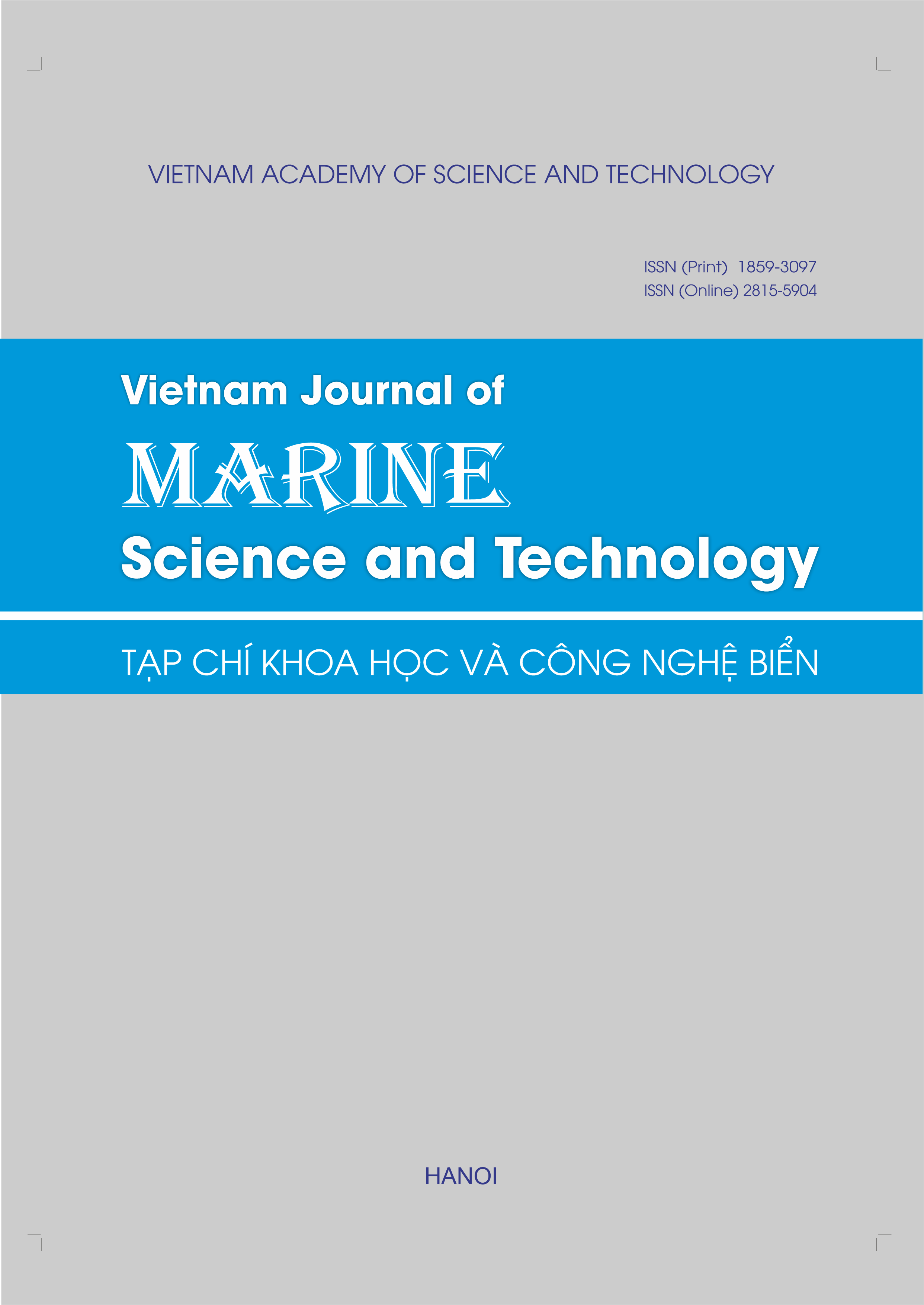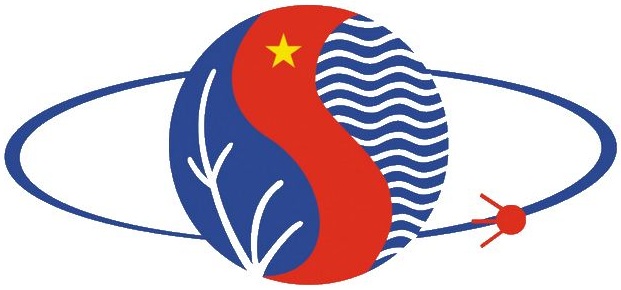Characterizing of ITS2 secondary structures reveals the geographical differentiation of seagrass Halophila ovalis (Hydrocharitaceae) in the world
Author affiliations
DOI:
https://doi.org/10.15625/1859-3097/20455Abstract
The seagrass Halophila is one of the genera of Hydrocharitaceae that shows the highest number of species, with around 20 species. Among them, H. ovalis, H. major, H. minor, and H. nipponica are closely related species. It is the first time ITS2 secondary structures and their phylogenetic utility in this genus were reported worldwide. Phylogenetic analysis based on 205 bp of ITS2 showed four clades corresponding to above species. ITS2 secondary structures showed insight into Halophila ovalis from the East coast of Africa. Halophila ovalis from the East coast of Africa showed a distinct variant in Helix 1, 2, and 3 compared to the worldwide populations. Therefore, the ITS2 locus should be used as a DNA barcode for identifying Halophila species.
Downloads
References
[1] Strydom, S., Webster, C. L., McCallum, R., Lafratta, A., O’Dea, C. M., Said, N. E., Inostroza, K., Salinas, C., Billinghurst, S., Phelps, C. M., Campbell, C., Gorham, C., Dunham, N., Bernasconi, R., Frouws, A. M., Werner, A., Vitelli, F., Puigcorbé, V., D'Cruz, A., McMahon, K. M., Robinson, J., Huggett, M. J., McNamara, S., Hyndes, G. A., and Serrano, O., 2021. Global database of key seagrass structure, biomass and production variables. PANGAEA.
[2] Unsworth, R. K., Cullen-Unsworth, L. C., Jones, B. L., and Lilley, R. J., 2022. The planetary role of seagrass conservation. Science, 377(6606), 609–613.
[3] McKenzie, L. J., Nordlund, L. M., Jones, B. L., Cullen-Unsworth, L. C., Roelfsema, C., and Unsworth, R. K., 2020. The global distribution of seagrass meadows. Environmental Research Letters, 15(7), 074041.
[4] Short, F. T., Polidoro, B., Livingstone, S. R., Carpenter, K. E., Bandeira, S., Bujang, J. S., Calumpong, H. P., Carruthers, T. J. B., Coles, R. G., Dennison, W. C., Erftemeijer, P. L. A., Fortes, M. D., Freeman, A. S., Jagtap, T. G., Kamal, A. H. M., Kendrick, G. A., Kenworthy, W. J., Nafie, Y. A. L., Nasution, I. M., Orth, R. J., Prathep, A., Sanciangco, J. C., van Tussenbroek, B., Vergara, S. G., Waycott, M., and Zieman, J. C., 2011. Extinction risk assessment of the world’s seagrass species. Biological Conservation, 144(7), 1961–1971.
[5] Dunic, J. C., Brown, C. J., Connolly, R. M., Turschwell, M. P., and Côté, I. M., 2021. Long‐term declines and recovery of meadow area across the world’s seagrass bioregions. Global Change Biology, 27(17), 4096–4109. doi: 10.1111/gcb.15684
[6] Kuo, J., 2020. Taxonomy of the genus Halophila Thouars (Hydocharitaceae): a review. Plants, 9(12), 1732.
[7] Uchimura, M., Faye, E. J., Shimada, S., Arai, S., Inoue, T., and Nakamura, Y., 2006. A re-evaluation of the taxonomic status of Halophila euphlebia Makino (Hydrocharitaceae) based on morphological features and ITS sequence data. Botanica Marina, 49, 111–121.
[8] Annaletchumy, L., Japar Sidik, B., Muta Harah, Z., and Arshad, A., 2005. Morphology of Halophila ovalis (R. Br.) Hook. f. from peninsular and east Malaysia. Pertanika Journal of Tropical Agricultural Science (Malaysia), 28, 1–11.
[9] Waycott, M., Freshwater, D. W., York, R. A., Calladine, A., and Kenworthy, W. J., 2002. Evolutionary trends in the seagrass genus Halophila (Thouars): insights from molecular phylogeny. Bulletin of Marine Science, 71(3), 1299–1308.
[10] Marwal, A., Sahu, A. K., and Gaur, R. K., 2014. Molecular markers: tool for genetic analysis. In Animal Biotechnology. Academic Press. pp. 289–305.
[11] Uchimura, M., Faye, E. J., Shimada, S., Inoue, T., and Nakamura, Y., 2008. A reassessment of Halophila species (Hydrocharitaceae) diversity with special reference to Japanese representatives. Botanica Marina, 51, 258–268.
[12] Lucas, C., Thangaradjou, T., and Papenbrock, J., 2012. Development of a DNA barcoding system for seagrasses: successful but not simple. Plos one, 7(1), e29987.
[13] Short, F. T., Moore, G. E., and Peyton, K. A., 2010. Halophila ovalis in the tropical Atlantic Ocean. Aquatic Botany, 93(3), 141–146. doi: 10.1016/j.aquabot.2010.05.001
[14] Singh, S., Southgate, P. C., and Lal, M. M., 2019. Morphological plasticity in a Fijian Seagrass: Halophila ovalis subsp. bullosa. Regional Studies in Marine Science, 32, 100809.
[15] Nguyen, X. V., Kletschkus, E., Rupp-Schröder, S. I., El Shaffai, A., and Papenbrock, J., 2018. rDNA analysis of the Red Sea seagrass, Halophila, reveals vicariant evolutionary diversification. Systematics and Biodiversity, 16(7), 668–679.
[16] Waycott, M., van Dijk, K. J., Calladine, A., Bricker, E., and Biffin, E., 2021. Genomics-Based Phylogenetic and Population Genetic Analysis of Global Samples Confirms Halophila johnsonii Eiseman as Halophila ovalis (R. Br.) Hook. f. Frontiers in Marine Science, 8, 740958.
[17] Yu, N., Wei, Y. L., Zhang, X., Zhu, N., Wang, Y. L., Zhu, Y., Zhang, H. P., Li, F. M., Yang, L., Sun, J. Q., and Sun, A. D., 2017. Barcode ITS2: a useful tool for identifying Trachelospermum jasminoides and a good monitor for medicine market. Scientific Reports, 7(1), 5037.
[18] Blaalid, R., Kumar, S., Nilsson, R. H., Abarenkov, K., Kirk, P. M., and Kauserud, H., 2013. ITS 1 versus ITS 2 as DNA metabarcodes for fungi. Molecular ecology resources, 13(2), 218–224.
[19] Hadi, S. I., Santana, H., Brunale, P. P., Gomes, T. G., Oliveira, M. D., Matthiensen, A., Oliveira, M. E. C., Silva, F. C., and Brasil, B. S., 2016. DNA barcoding green microalgae isolated from neotropical inland waters. PloS one, 11(2), e0149284.
[20] Anaz, M., Sasidharan, N., Remakanthan, A., and Dilsha, M. V., 2021. ITS 2 and RNA secondary structure-based analysis reveals a clear picture on phylogeny of South Indian Salacia spp. Computational Biology and Chemistry, 91, 107438.
[21] Adebowale, A., Lamb, J., Nicholas, A., and Naidoo, Y., 2016. ITS2 secondary structure for species circumscription: case study in southern African Strychnos L. (Loganiaceae). Genetica, 144, 639–650.
[22] Müller, T., Philippi, N., Dandekar, T., Schultz, J., and Wolf, M., 2007. Distinguishing species. RNA, 13(9), 1469–1472.
[23] Zhang, W., Yuan, Y., Yang, S., Huang, J., and Huang, L., 2015. ITS2 secondary structure improves discrimination between medicinal “Mu Tong” species when using DNA barcoding. PLoS One, 10(7), e0131185.
[24] Saha, P. S., Sengupta, M., and Jha, S., 2017. Ribosomal DNA ITS1, 5.8 S and ITS2 secondary structure, nuclear DNA content and phytochemical analyses reveal distinctive characteristics of four subclades of Protasparagus. Journal of Systematics and Evolution, 55(1), 54–70.
[25] Feng, S., Jiang, M., Shi, Y., Jiao, K., Shen, C., Lu, J., Ying, Q., and Wang, H., 2016. Application of the ribosomal DNA ITS2 region of Physalis (Solanaceae): DNA barcoding and phylogenetic study. Frontiers in plant science, 7, 1047.
[26] Özgişi, K., 2020. Structural characterization of ITS2 and CBC species concept applications in the tribe Coluteocarpeae (Brassicaceae). Turkish Journal of Botany, 44(3), 295–308.
[27] Yao, H., Song, J., Liu, C., Luo, K., Han, J., Li, Y., Pang, X., Xu, H., Zhu, Y., Xiao, P., and Chen, S., 2010. Use of ITS2 region as the universal DNA barcode for plants and animals. PloS one, 5(10), e13102.
[28] Vieira, C., Kim, M. S., N’yeurt, A. D. R., Payri, C., D’hondt, S., De Clerck, O., and Zubia, M., 2023. Marine flora of French Polynesia: An updated list using DNA barcoding and traditional approaches. Biology, 12(8), 1124.
[29] Lusana, J. L., and Robert Lugendo, B., 2023. Delineating seagrass species in the genera Halodule and Halophila from Tanzanian coastal waters using ITS and rbcL DNA barcoding. Nordic Journal of Botany, 2023(3), e03823.
[30] Nguyen, V. X., Detcharoen, M., Tuntiprapas, P., Soe-Htun, U., Sidik, J. B., Harah, M. Z., Prathep, A., and Papenbrock, J., 2014. Genetic species identification and population structure of Halophila (Hydrocharitaceae) from the Western Pacific to the Eastern Indian Ocean. BMC Evolutionary Biology, 14, 92.
[31] Nguyen, X. V., Höfler, S., Glasenapp, Y., Thangaradjou, T., Lucas, C., and Papenbrock, J., 2015. New insights into DNA barcoding of seagrasses. Systematics and Biodiversity, 13(5), 496–508.
[32] Liu, S. Y. V., Kumara, T. P., and Hsu, C. H., 2020. Genetic identification and hybridization in the seagrass genus Halophila (Hydrocharitaceae) in Sri Lankan waters. PeerJ, 8, e10027.
[33] Tuntiprapas, P., Shimada, S., Pongparadon, S., Prathep, A., Saensouk, P., Theerakulpisut, P., and Kerdphol, R., 2015. Is Halophila major (Zoll.) Miquel a big H. ovalis (R. Brown) JD Hooker? An evaluation based on age, morphology, and ITS sequence. Sci. Asia, 41(2), 79–86.
[34] Kwan, V., Shantti, P., Lum, E. Y. Y., Ow, Y. X., and Huang, D., 2023. Diversity and phylogeny of seagrasses in Singapore. Aquatic Botany, 187, 103648.
[35] Vy, N. X., Holzmeyer, L., and Papenbrock, J., 2013. New record of the seagrass species Halophila major (Zoll.) Miquel in Vietnam: evidence from leaf morphology and ITS analysis. Botanica marina, 56(4), 313–321.
[36] Lin, X., Dong, J., Yang, Q., Zhou, W., Wang, Y., Zhang, Y., Ahmad, M., Sun, Y., Wang, Y., and Ling, J., 2021. Identification of three seagrass species in coral reef ecosystem by using multiple genes of DNA barcoding. Ecotoxicology, 30, 919–928.
[37] Liu, S. Y. V., and Hsu, C. H., 2021. Genetic analyses reveal fine-scale genetic structure between lagoon and open water spoon seagrass (Halophila ovalis) populations around Dongsha Island. Aquatic Botany, 174, 103421.
[38] Katoh, K., and Standley, D. M., 2013. MAFFT multiple sequence alignment software version 7: improvements in performance and usability. Molecular biology and evolution, 30(4), 772–780.
[39] Darriba, D., Taboada, G. L., Doallo, R., and Posada, D., 2012. jModelTest 2: more models, new heuristics and parallel computing. Nature Methods 9: 772.
[40] Stamatakis, A., 2014. RAxML version 8: a tool for phylogenetic analysis and post-analysis of large phylogenies. Bioinformatics, 30(9), 1312–1313.
[41] Ronquist, F., Teslenko, M., Van Der Mark, P., Ayres, D. L., Darling, A., Höhna, S., Larget, B., Liu, L., Suchard, M. A., and Huelsenbeck, J. P., 2012. MrBayes 3.2: efficient Bayesian phylogenetic inference and model choice across a large model space. Systematic biology, 61(3), 539–542.
[42] Huson, D. H., and Scornavacca, C., 2012. Dendroscope 3: an interactive tool for rooted phylogenetic trees and networks. Systematic biology, 61(6), 1061–1067.
[43] Koetschan, C., Förster, F., Keller, A., Schleicher, T., Ruderisch, B., Schwarz, R., Müller, T., Wolf, M., and Schultz, J., 2010. The ITS2 Database III—sequences and structures for phylogeny. Nucleic acids research, 38(suppl_1), D275–D279.
[44] Selig, C., Wolf, M., Müller, T., Dandekar, T., and Schultz, J., 2007. The ITS2 Database II: homology modelling RNA structure for molecular systematics. Nucleic acids research, 36(suppl_1), D377–D380.
[45] Seibel, P. N., Müller, T., Dandekar, T., Schultz, J., and Wolf, M., 2006. 4SALE–a tool for synchronous RNA sequence and secondary structure alignment and editing. BMC bioinformatics, 7, 1–7.
[46] Seibel, P. N., Müller, T., Dandekar, T., and Wolf, M., 2008. Synchronous visual analysis and editing of RNA sequence and secondary structure alignments using 4SALE. BMC research notes, 1, 1–7.
[47] Li, M., Zhao, H., Zhao, F., Jiang, L., Peng, H., Zhang, W., and Simmons, M. P., 2019. Alternative analyses of compensatory base changes in an ITS2 phylogeny of Corydalis (Papaveraceae). Annals of Botany, 124(2), 233–243.
[48] Darty, K., Denise, A., and Ponty, Y., 2009. VARNA: Interactive drawing and editing of the RNA secondary structure. Bioinformatics, 25(15), 1974.
[49] Skelton, P. A., and South, G. R., 2006. Seagrass biodiversity of the Fiji and Samoa islands, South Pacific. New Zealand Journal of Marine and Freshwater Research, 40(2), 345–356.
[50] Chen, F. R., Guo, Q. S., Yang, F., Zhu, Z. B., and Wang, T., 2019. Application of ITS2 secondary structure phylogenetic information in DNA barcode identification of Chrysanthemum indicum and its related plants. Zhongguo Zhong yao za zhi= Zhongguo Zhongyao Zazhi= China Journal of Chinese Materia Medica, 44(22), 4813–4819.
[51] Sundaresan, N., Jagan, E. G., Kathamuthu, G., and Pandi, M., 2019. Internal transcribed spacer 2 (ITS2) molecular morphometric analysis based species delimitation of foliar endophytic fungi from Aglaia elaeagnoidea, Flacourtia inermis and Premna serratifolia. Plos one, 14(4), e0215024.
[52] Yan, D. H., Gao, Q., Sun, X., Song, X., and Li, H., 2018. ITS2 sequence–structure phylogeny reveals diverse endophytic Pseudocercospora fungi on poplars. Genetica, 146, 187–198.
[53] Caisová, L., Marin, B., and Melkonian, M., 2013. A consensus secondary structure of ITS2 in the Chlorophyta identified by phylogenetic reconstruction. Protist, 164(4), 482–496.
Downloads
Published
How to Cite
Issue
Section
License
Copyright (c) 2024 Vietnam Academy of Science and Technology

This work is licensed under a Creative Commons Attribution-NonCommercial-NoDerivatives 4.0 International License.








